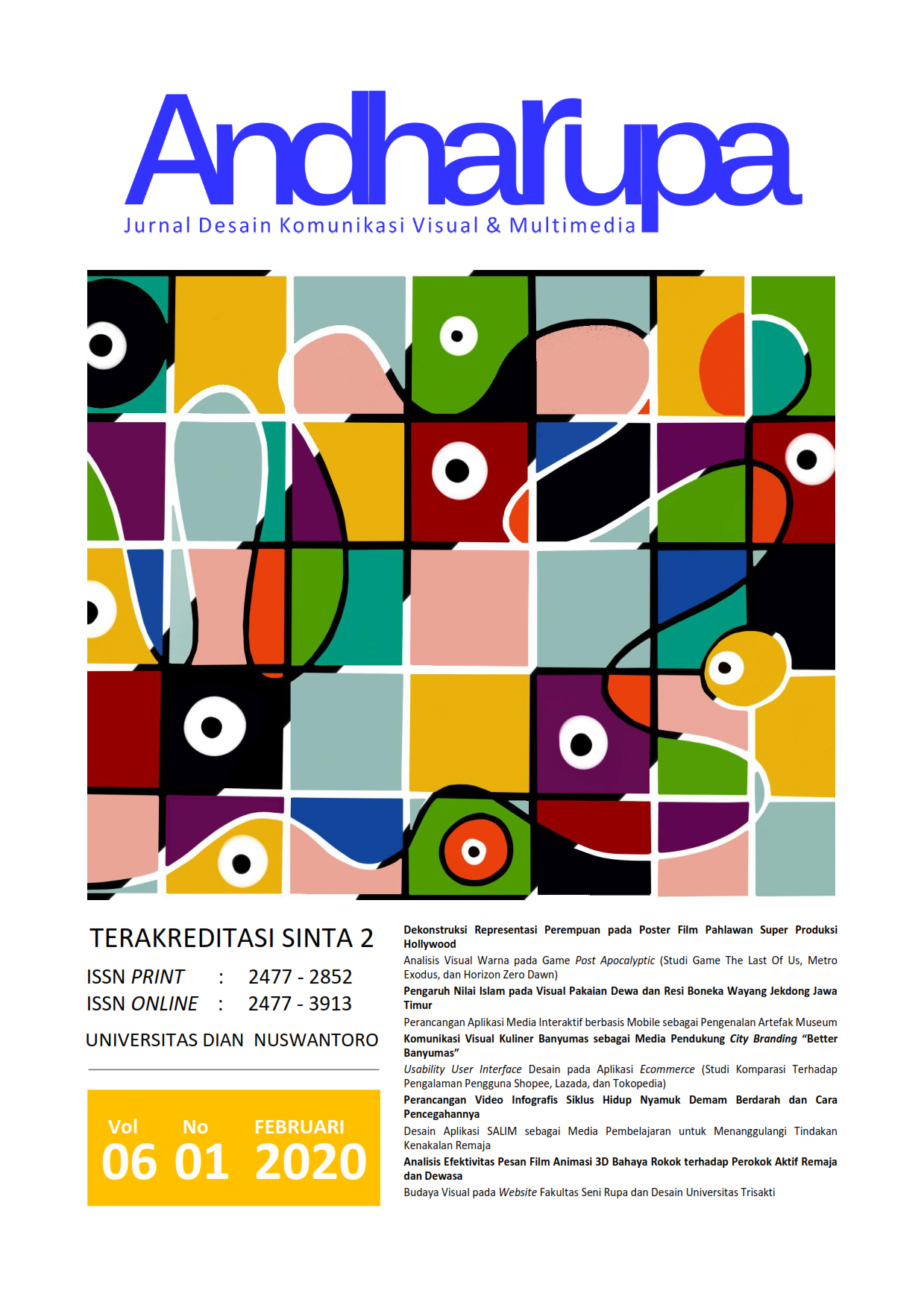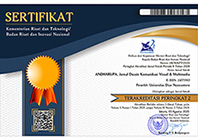Komunikasi Visual Kuliner Banyumas sebagai Media Pendukung City Branding "Better Banyumas"
DOI:
https://doi.org/10.33633/andharupa.v6i1.2733Abstract
AbstrakBetter Banyumas menjadi tagline city branding dari Kabupaten Banyumas. Dalam implementasinya identitas dari perumusan tersebut belum dapat dipahami sebagai jaringan asosiasi atau persepsi dalam benak konsumen mengenai produk (dalam hal ini kota). Beberapa produk Banyumas memiliki diferensiasi dengan kota lainnya, seperti bahasa, geografis alam, dan kuliner yang unik. Kuliner Banyumas dapat menjadi salah satu identitas yang diangkat sebagai simbol keunikan untuk mempopulerkan Banyumas. Penelitian ini bersifat deskriptif kualitatif. Pengumpulan data diperoleh dari hasil studi lapangan, studi literatur, dan dokumentasi kuliner Banyumas. Dalam penelitian ini, peneliti mengambil sampel berdasarkan kuisioner yang telah disebarkan kepada 143 responden. Dari 17 populasi kuliner yang ada, diambil 13 sampel yang dijadikan data perancangan pada penelitian. Sampel tersebut diambil secara purposive sampling dengan melihat perolehan responden lebih dari 5%. Dari hasil pengambilan sampling, kuliner Banyumas tersebut kemudian dibagi menjadi tiga kategori, yaitu makanan, minuman, dan oleh-oleh khas Banyumas. Hasil dari penelitian ini adalah rumusan pemanfaatan media komunikasi visual dalam konten media sosial yang mudah ditemui oleh masyarakat luas. Fungsi komunikasi visual dapat menjadi media identifikasi, informasi, dan persuasi yang diharapkan mampu menjadi media pendukung dalam upaya pemerintah untuk memperkenalkan Banyumas melalui kuliner. Di lain sisi, komunikasi visual ini bertujuan meningkatkan citra Banyumas sebagai salah satu destinasi wisata.Kata kunci: Banyumas, city branding, komunikasi visual, kuliner AbstractBetter Banyumas became the city branding tagline of the Banyumas district. In the implementation, the identity of the formulation has not understood as network associations or perceptual within the mind of the customer (in this case is the city). Some of Banyumas products have Differentiation with other cities, such as language, natural geography, and unique culinary. Banyumas culinary can be one of the identities appointed as a symbol of uniqueness to popularize Banyumas. This research used descriptive qualitative. Data ware obtained from the research field studies, literature studies, and Banyumas culinary documentation. In this research, researchers took samples based on questionnaires that have distributed to 143 respondents. From 17 existing culinary populations, 13 samples ware taken and used as design data in the study. The sample had taken in purposive sampling by looking at the respondent'sacquisition of more than 5%. From the results sampling, Banyumas culinary divided into three categories, which are foods, drinks, and typical souvenirs of Banyumas. The results of this research are the use of visual communication media in social media content easily found by the wider society. The visual communication function can be a medium of identification, information, and persuasion which expected to become supporting media in the government order to introduce Banyumas through culinary. On the other hand, visual communication aims to improve Banyumas Image as one of the tourism destinations.Keywords: Banyumas, city branding ,culinary, visual communicationReferences
Badan Ekonomi Kreatif. (2018). Data Statistik dan Hasil Survei, 23. Retrieved from http://www.bekraf.go.id/pustaka/page/data-statistik-dan-hasil-survei-khusus-ekonomi-kreatif
Harmayani, Eni. (2017). Makanan Tradisional Indonesia. Yogyakarta : Gadjah Mada University Press.
Hermawati, Sri & Milawaty, Yushe. (2016). Potensi Industri Pariwisata Kabupaten Banyumas. Jurnal Ekonomi Bisnis Volume 21 No.3
Lazuardi, M, & Triady, MS. (2015). Rencana Pengembangan Kuliner Nasional 2015-2019. Ekonomi Kreatif (p. 6).
Lutfi Eliazer, S., Bahruddin, M., & Aziz, A. (2013). Pembuatan Buku Makanan Tradisional Surabaya Sebagai Upaya Pelestarian Produk Lokal. Jurnal Desain Komunikasi Visual, 1(1), 87–95.
Malada, CA. (2017). Perancangan Visual Branding Lontong Balap Pak Gendut Sebagai Kuliner Khas Surabaya. Jurnal DKV Adiwarna.
Moleong, L. J. (2017). Metodologi Penelitian Kualitatif (Edisi Revisi). In PT. Remaja Rosda Karya.
Anindia, Nur Raesa. (2014). Perancangan Komunikasi Visual Publikasi Buku Jajanan Tradisional Solo. Jurnal School of Design Universitas Bina Nusantara
Setiawan, Venny. (2015). Perancangan Komunikasi Visual Publikasi Ilustrasi Gerobak Kuliner Indonesia: Edisi Betawi. Jurnal Universitas Bina Nusantara.
Sukmaraga, Ayyub Ashari & Nirwana, Aditya. (2016). City Branding : Sebuah Tinjauan Metodologis dengan Pendekatan Elaboratif, Praktis dan Ilmiah. JADECS Vol 1 No, 1
Swaratama, E. (2018). Perancangan Komunikasi Visual Nopia sebagai Kuliner Khas Kabupaten Banyumas. DeKaVe, 9(1).
Downloads
Published
Issue
Section
License
Copyright (c) 2020 ANDHARUPA: Jurnal Desain Komunikasi Visual & Multimedia

This work is licensed under a Creative Commons Attribution 4.0 International License.
Authors who publish with this journal agree to the following terms:
- Authors retain copyright and grant the journal right of first publication with the work simultaneously licensed under a Creative Commons Attribution License that allows others to share the work with an acknowledgment of the work's authorship and initial publication in this journal.
- Authors are able to enter into separate, additional contractual arrangements for the non-exclusive distribution of the journal's published version of the work (e.g., post it to an institutional repository or publish it in a book), with an acknowledgment of its initial publication in this journal.
- Authors are permitted and encouraged to post their work online (e.g., in institutional repositories or on their website) prior to and during the submission process, as it can lead to productive exchanges, as well as earlier and greater citation of published work (See The Effect of Open Access).















